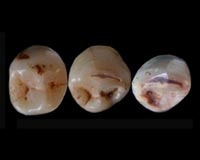| . |  |
. |
Gainesville FL (SPX) Feb 16, 2011 "Man is but a worm" was the title of a famous caricature of Darwin's ideas in Victorian England. Now, 120 years later, a molecular analysis of mysterious marine creatures unexpectedly reveals our cousins as worms, indeed. An international team of researchers, including a neuroscientist from the University of Florida, has produced more evidence that people have a close evolutionary connection with tiny, flatworm-like organisms scientifically known as "Acoelomorphs." The research in the Thursday (Feb. 10) issue of Nature offers insights into brain development and human diseases, possibly shedding light on animal models used to study development of nerve cells and complex neurodegenerative diseases such as Alzheimer's and Parkinson's. "It was like looking under a rock and finding something unexpected," said Leonid L. Moroz, a professor in the department of neuroscience with the UF College of Medicine. "We've known there were very unusual twists in the evolution of the complex brains, but this suggests the independent evolution of complex brains in our lineage versus invertebrates, for example, in lineages leading to the octopus or the honeybee." The latest research indicates that of the five animal phyla, the highest classification in our evolutionary neighborhood, four contain worms. But none are anatomically simpler than "acoels," which have no brains or centralized nervous systems. Less than a few millimeters in size, acoels are little more than tiny bags of cells that breathe through their skin and digest food by surrounding it. Comparing extensive genome-wide data, mitochondrial genes and tiny signaling nucleic acids called microRNAs, the researchers hailing from six countries determined a strong possibility that acoels and their kin are "sisters" to another peculiar type of marine worm from northern seas, called Xenoturbella. From there, like playing "Six Degrees of Kevin Bacon," the branches continue to humans. "If you looked at one of these creatures you would say, 'what is all of this excitement about a worm?'" said Richard G. Northcutt, a professor of neurosciences at Scripps Institution of Oceanography, who was not involved in the study. "These are tiny animals that have almost no anatomy, which presents very little for scientists to compare them with. But through genetics, if the analysis is correct - and time will tell if it is - the study has taken a very bothersome group that scientists are not sure what to do with and says it is related to vertebrates, ourselves and echinoderms (such as starfish). "The significance of the research is it gives us a better understanding of how animals are related and, by inference, a better understanding of the history of the animals leading to humans," Northcutt said. Scientists used high-throughput computational tools to reconstruct deep evolutionary relationships, apparently confirming suspicions that three lineages of marine worms and vertebrates are part of a common evolutionary line called "deuterostomes," which share a common ancestor. "The early evolution of lineages leading to vertebrates, sea stars and acorn worms is much more complex than most people expect because it involves not just gene gain, but enormous gene loss," said Moroz, who is affiliated with the Whitney Laboratory for Marine Bioscience and UF's McKnight Brain Institute. "An alternative, yet unlikely, scenario would be that our common ancestor had a central nervous system, and then just lost it, still remaining a free living organism. Understanding the complex cellular rearrangements and the origin of animal innovations, such as the brain, is critically important for understanding human development and disease, Moroz said. "We need to be able to interpret molecular events in the medical field," he said. "Is what's happening in different lineages of neuronal and stem cells, for example, completely new, or is it reflecting something that is in the arrays of ancestral tool kits preserved over more than 550 million years of our evolutionary history? Working with models of human disease, you really need to be sure." Scientists on the research team include Herve Philippe of the University of Montreal, Henner Brinkmann and Richard R. Copley of the Wellcome Trust Center for Human Genetics in Oxford, Hiroaki Nakano of the University of Tsukuba in Japan, Albert J. Poustka of the Max-Planck Institute in Berlin, Andreas Wallberg of Uppsala University in Sweden, Kevin J. Peterson of Dartmouth College in New Hampshire and Maximilian J. Telford of University College London.
Share This Article With Planet Earth
Related Links University of Florida All About Human Beings and How We Got To Be Here
 Ancient Teeth Raise New Questions About The Origins Of Modern Man
Ancient Teeth Raise New Questions About The Origins Of Modern ManBinghamton, NH (SPX) Feb 16, 2011 Eight small teeth found in a cave near Rosh Haain, central Israel, are raising big questions about the earliest existence of humans and where we may have originated, says Binghamton University anthropologist Rolf Quam. Part of a team of international researchers led by Dr. Israel Hershovitz of Tel Aviv University, Qaum and his colleagues have been examining the dental discovery and recentl ... read more |
|
| The content herein, unless otherwise known to be public domain, are Copyright 1995-2010 - SpaceDaily. AFP and UPI Wire Stories are copyright Agence France-Presse and United Press International. ESA Portal Reports are copyright European Space Agency. All NASA sourced material is public domain. Additional copyrights may apply in whole or part to other bona fide parties. Advertising does not imply endorsement,agreement or approval of any opinions, statements or information provided by SpaceDaily on any Web page published or hosted by SpaceDaily. Privacy Statement |